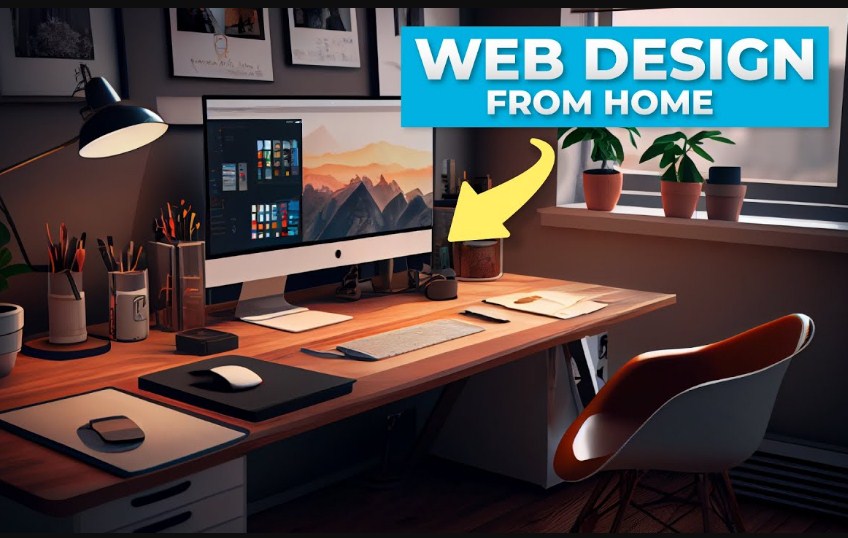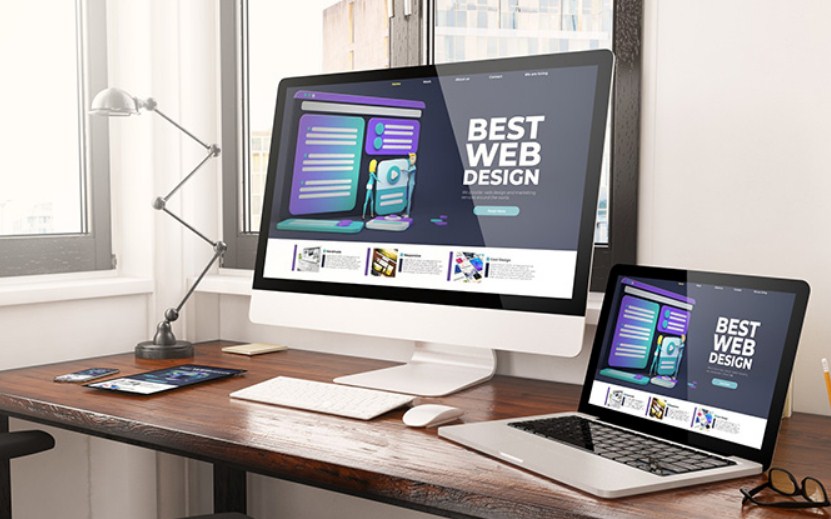Starting a web design business from home can be an exciting and rewarding venture, especially in today’s digital age. Whether you’re a seasoned designer or a beginner, with the right tools, knowledge, and strategy, you can turn your passion for web design into a profitable business. In this article, we will guide you through the essential steps to starting your own web design business, the benefits of working from home, top tools and products you’ll need, and how to get started successfully.

Why Start a Web Design Business from Home?
A web design business is one of the most accessible businesses to start from home. The demand for websites and digital design continues to grow as businesses, bloggers, and entrepreneurs require online presences to stay competitive. Starting a web design business from home offers several benefits:
- Low Overhead Costs: No need for office space or other high costs associated with traditional businesses.
- Flexible Schedule: You can set your own working hours, giving you the freedom to balance personal life and work.
- Unlimited Earning Potential: As a business owner, your income will directly reflect the amount of work you put in.
- Creative Freedom: You can work on projects that excite you and build a portfolio that reflects your skills.
Now, let’s dive into the key steps involved in starting a web design business from home.
Steps to Start Your Own Web Design Business

1. Learn the Basics of Web Design
Before you start your own business, you must have a solid foundation in web design. If you’re a beginner, it’s important to learn HTML, CSS, JavaScript, and other key web design tools. There are numerous online resources to help you learn, including:
- FreeCodeCamp: A free resource for learning web development.
- Udemy: Offers both beginner and advanced web design courses.
- W3Schools: Provides tutorials and references for web development.
2. Develop Your Skills
Beyond just learning the basics, you must practice and refine your web design skills. Work on personal projects, redesign websites, or offer services for free or at a discount to build a portfolio. Here’s what to focus on:
- UI/UX Design: Understanding how to create user-friendly designs.
- Responsive Design: Making sure websites look great on all devices.
- SEO Fundamentals: Learning how to design websites that are optimized for search engines.
3. Set Up Your Business Structure
Before launching your business, ensure that you have the right legal structure in place. Depending on your location, you may need to:
- Register your business: Check the local regulations for registering a business.
- Get a business license: Some areas may require you to have a business license.
- Set up accounting: Consider using tools like QuickBooks or FreshBooks to keep track of your earnings and expenses.
4. Build Your Website & Portfolio
You need a professional website that showcases your web design skills. Consider using a platform like WordPress, Wix, or Webflow to build your site. Your portfolio should include:
- Personal Projects: Any websites or web designs you’ve created.
- Client Work: If you’ve worked with clients, show off those projects.
- Testimonials: If possible, get testimonials from past clients to enhance credibility.
5. Market Your Services
Now that your business is set up, it’s time to attract clients. Here are several strategies you can use:
- Social Media Marketing: Promote your services on platforms like Instagram, Facebook, and LinkedIn.
- Networking: Join web design and entrepreneurship groups to meet potential clients.
- Search Engine Optimization (SEO): Optimize your website to rank higher in search results, making it easier for clients to find you.
Essential Tools & Products for Starting a Web Design Business
Having the right tools is essential for starting and growing a web design business. Below are some top products that can help streamline your workflow, enhance your designs, and boost your productivity. 🚀
1. Adobe Creative Cloud Suite
Adobe Creative Cloud is a must-have suite for any web designer. It includes powerful software like Photoshop, Illustrator, and Adobe XD, which are essential for creating stunning visuals, graphics, and web prototypes.
| Feature | Pros | Cons | Price |
|---|---|---|---|
| Adobe Photoshop | Industry standard for photo editing | Can be expensive for beginners | $52.99/month |
| Adobe Illustrator | Perfect for vector graphics | Requires high system resources | $52.99/month |
| Adobe XD | Excellent for web and mobile UI design | Learning curve for beginners | $9.99/month |
Benefits:
- High-quality design tools: Create professional-grade graphics and designs.
- Industry-standard software: Widely recognized, making it easier to collaborate with clients.
How to Buy: You can purchase the Adobe Creative Cloud Suite from the official website.
2. Figma
Figma is a popular collaborative design tool for UI/UX designers. It allows multiple people to work on the same design in real-time, which is perfect for collaborating with clients and teams.
| Feature | Pros | Cons | Price |
|---|---|---|---|
| Real-time Collaboration | Ideal for teamwork | Limited offline access | Free/ $12/month (for Pro) |
| Prototyping & Wireframing | Easy to use for UI/UX designs | Limited offline features | $12/month |
Benefits:
- Collaboration: Work simultaneously with clients or teams on design projects.
- Cloud-based: Access your designs anywhere, even on mobile.
How to Buy: You can sign up for Figma via their official website.
3. Webflow
Webflow is a powerful web design and development platform that allows you to build responsive websites without writing a single line of code. It’s perfect for designers who want to focus on the creative aspect while Webflow handles the coding part.
| Feature | Pros | Cons | Price |
|---|---|---|---|
| Visual Web Design | No coding required | Limited integrations | Free/ $12/month (Basic Plan) |
| Responsive Web Design | Automatically scales across devices | Steeper learning curve | $16/month (CMS Plan) |
Benefits:
- No-code web design: Create full websites with drag-and-drop functionality.
- SEO-friendly: Automatically optimize websites for search engines.
How to Buy: You can purchase Webflow’s subscription on their official site.
Comparison Table: Web Design Tools for Home Business
| Product | Best For | Key Features | Price |
|---|---|---|---|
| Adobe Creative Cloud | Advanced design & graphics | Photoshop, Illustrator, XD | $52.99/month |
| Figma | Collaboration & UI/UX design | Real-time collaboration | Free / $12/month |
| Webflow | No-code web design | Drag-and-drop website creation | Free / $12-16/month |
How to Buy the Best Tools for Your Web Design Business 🛍️
To succeed in your web design business, it’s crucial to invest in the right tools. The products mentioned above are available through their official websites.
For Adobe Creative Cloud, visit Adobe and select the plan that best suits your needs.
For Figma, sign up directly on Figma’s website, and choose the free or paid version based on your needs.
For Webflow, you can sign up at Webflow’s official site and start building without coding.
Where to Buy?
All of the above tools can be purchased online. You can either subscribe directly from the company websites or check other software marketplaces like:
5 FAQs About Starting a Web Design Business from Home
1. What skills do I need to start a web design business from home?
You’ll need proficiency in web design software, HTML, CSS, and an understanding of user experience (UX) design principles. Basic SEO and digital marketing skills are also important.
2. How can I find clients for my web design business?
You can find clients through networking, social media, freelance platforms (like Upwork and Fiverr), or by optimizing your website for search engines to attract organic traffic.
3. Is it expensive to start a web design business from home?
The initial costs can be low if you already have the necessary hardware (laptop or desktop). The biggest investments will be in software tools and possibly a website.
4. How much can I earn from a home-based web design business?
The earning potential depends on your skill level, client base, and pricing. Many web designers charge anywhere from $50 to $150 per hour, and some even earn six figures.
5. Do I need a business license to start a web design business from home?
This depends on your location. Check with local authorities to determine whether a business license is required in your area.
Starting a web design business from home is a fantastic way to combine creativity and entrepreneurship. By following the steps outlined above, investing in the right tools, and continually honing your skills, you can build a thriving and profitable web design business that fits your lifestyle!
Read More >>>